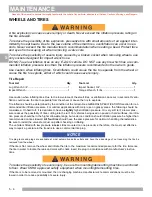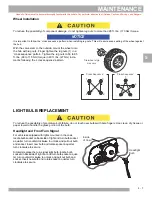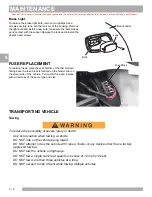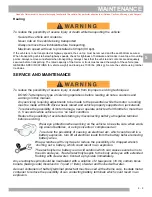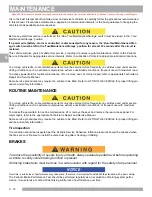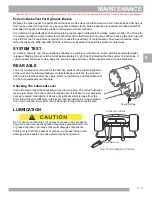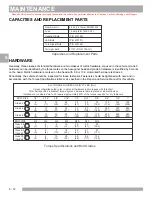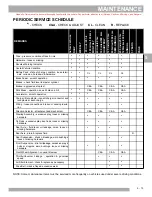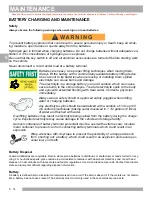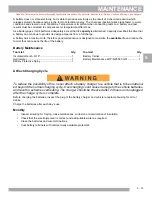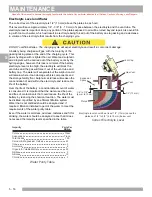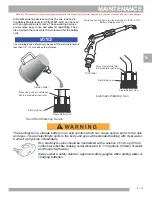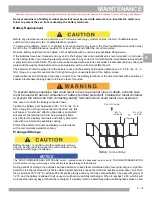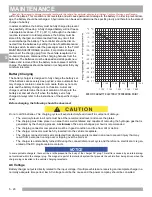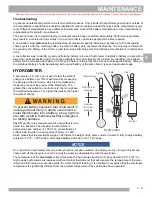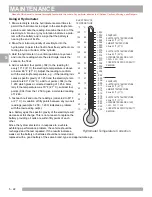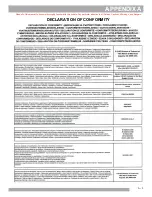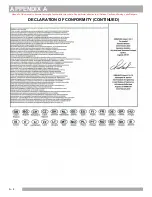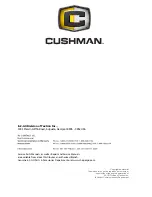
MAINTENANCE
Read all of this manual to become thoroughly familiar with this vehicle. Pay particular attention to all Notices, Cautions, Warnings, and Dangers.
5 - 20
5
within the plates. This condition is not reversible and will cause permanent damage to the battery. In order to prevent dam-
age, the battery should be recharged. A hydrometer can be used to determine the specific gravity and therefore the state of
charge of a battery.
In winter conditions, the battery must be fully charged to prevent
the possibility of freezing. A fully charged battery will not freeze
in temperatures above -75° F (-60° C). Although the chemical
reaction is slowed in cold temperatures, the battery must be
stored fully charged, and disconnected from any circuit that
could discharge the battery. The controller should be discon-
nected from the batteries by setting the Run-Tow/Maintenance/
Storage switch, located under the passenger seat, to the ‘TOW/
MAINTENANCE/STORAGE’ position. For portable chargers,
disconnect the charging plug from the vehicle receptacle. For
on-board chargers, disconnect the charging harness from the
batteries. The batteries must be cleaned and all deposits neu-
tralized and removed from the battery case to prevent self dis-
charge. The batteries should be tested or recharged at thirty day
minimum intervals.
Battery Charging
The battery charger is designed to fully charge the battery set.
If the batteries are severely deep cycled, some automatic bat-
tery chargers contain an electronic module that may not acti-
vate and the battery charger will not function. Automatic
chargers will determine the correct duration of charge to the
battery set and will shut off when the battery set is fully
charged. Always refer to the instructions of the specific charger
used.
Before charging, the following should be observed:
Do not overfill batteries. The charging cycle will expel electrolyte and result in component damage.
•
The electrolyte level in all cells must be at the recommended level and cover the plates.
•
The charging must take place in an area that is well ventilated and capable of removing the hydrogen gas that is
generated by the charging process. A
minimum
of five air exchanges per hour is recommended.
•
The charging connector components must be in good condition and free from dirt or debris.
•
The charger connector must be fully inserted into the vehicle receptacle.
•
The charger connector/cord set is protected from damage and is located in an area to prevent injury that may
result from personnel running over or tripping over the cord set.
•
The charger is automatically turned off during the connect/disconnect cycle and therefore no electrical arc is gen-
erated at the DC plug/receptacle contacts.
In some portable chargers, there will be a rattle present in the body of the charger DC plug. This rattle is caused by an internal mag-
net contained within the charger plug. The magnet is part of the interlock system that prevents the vehicle from being driven when the
charger plug is inserted in the vehicle charging receptacle.
AC Voltage
Battery charger output is directly related to the input voltage. If multiple vehicles are receiving an incomplete charge in a
normally adequate time period, low AC voltage could be the cause and the power company should be consulted.
1.100
1.120
1.160
1.200
1.240
1.280
1.140
1.180
1.220
1.260
1.300
-9
-15
-21
-26
-32
-37
-43
-48
-54
-60
-65
-71
E
L
E
C
T
R
O
L
Y
T
E
T
E
M
P
E
R
A
T
U
R
E
SPECIFIC GRAVITY ELECTROLYTE FREEZING POINT
O
C
+15
+5
-5
-15
-25
-35
-45
-55
-65
-75
-85
-95
O
F
NOTICE

